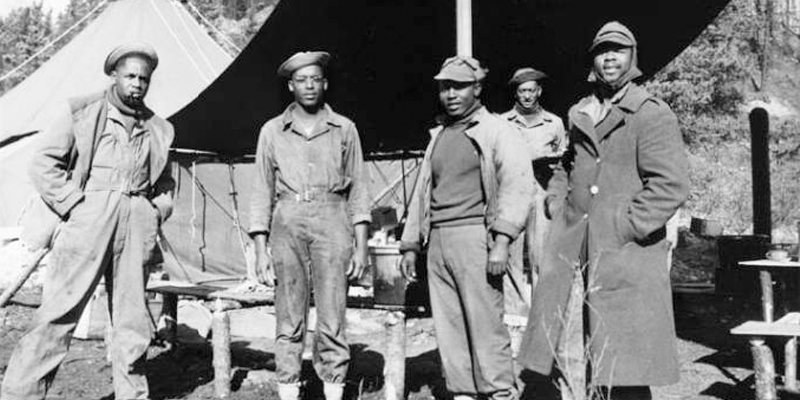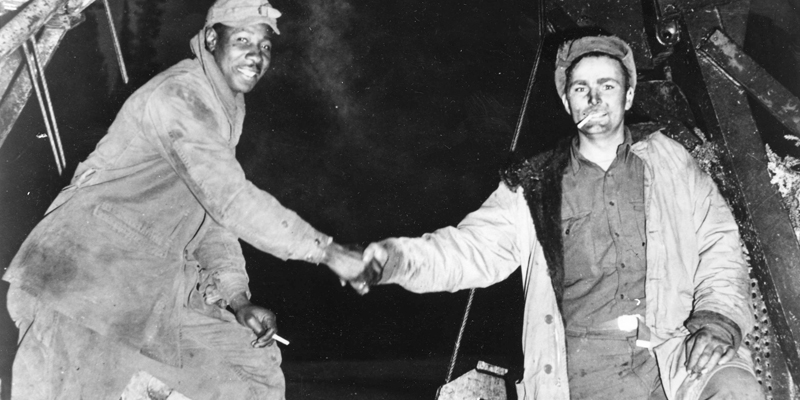
February memorializes the African-American engineers who helped build the Alaska Highway |
By Tara Lukasik, Periodicals Editor, International Code Council |
 |
| Historian Lael Morgan says the 10,000 U.S. Army Corp of Engineers soldiers who built the Alaska Highway included about 3,500 African-American engineers, who mainly worked from Alaska southward into Canada. Photo: National Archive |
| February marks Black History Month, an annual celebration of achievements by African-American men and women who have made significant contributions to America and the rest of the world in the fields of science, politics, law, sports, the arts, entertainment, and many other fields, including construction, architecture and engineering.
"African Americans in Times of War," the theme of this year's Black History Month, honors the critical role of black Americans during wartime. In February 1942, during the middle of World War II, former U.S. President Franklin D. Roosevelt authorized construction on the Alaska Highway to begin. The goal was to build a road to connect the far-flung territory of Alaska to the continental United States. A need to establish an overland route to supply Alaska in the face of Japanese aggression became very important to the U.S. government, and they wanted it done in less than one year. There was just one problem. Nearly all of the Army Corps of Engineers were firmly entrenched in the South Pacific, serving in the war. President Roosevelt and the War Department made the unprecedented decision to post three regiments of African-American engineers to the job — working alongside four white regiments. With the U.S. military operating under the laws of segregation — which included rules that stated African-Americans only being be sent to warm climates — as well as the prejudice that black workers were not qualified for the job, this was an unusual decision of the President. Despite working on the same project, the regiments were still kept segregated, and the white regiments often received preferential treatment in regard to equipment. For example, the African-American 95th Regiment, despite being more experienced with machinery, were given no machinery and provided only with hand tools. More than 10,000 U.S. Army soldiers — 3,500 of them African-American troops, about one-third — hacked their way through some 1,500 miles of rugged Canadian and Alaskan wilderness in about eight months to build the highway. Historians consider it one of the 20th century's greatest engineering feats. "A photo of two soldiers, one black and one white, who'd climbed down from their bulldozers to shake hands at Contact Creek captured what was a breakthrough in race relations for the military — and the nation." The African American soldiers proved themselves every bit the equal of their white counterparts as they endured bitter cold and snow, then torrential rain and mud and swarms of mosquitos — an estimated 30 men died during the construction. Despite a chronic lack of supplies and equipment, they proved their mettle and got the job done. The project served as a bonding experience for many of the men. The black troops met the white soldiers units on Oct. 25, 1942, at Contact Creek, near milepost 590 in the Yukon Territory. A photo of two soldiers, one black and one white, who'd climbed down from their bulldozers to shake hands at Contact Creek captured what was a breakthrough in race relations for the military — and the nation. The gravel road opened to supply trucks and other vehicles in November 1942. The following year, contractors worked on the permanent road, following much of the original route. A 1944 military documentary called it "one of the wonders of the modern world." The highway, which runs from Dawson Creek in British Columbia to Alaska's Delta Junction, opened to general civilian traffic in 1948. The Black Veterans Memorial Bridge, one of the veterans memorials along the highway, was dedicated in 1993 and stands as a monument to the engineers who not only completed a difficult task, but helped to pave the way for armed forces integration. Until 1993, little more than a historical footnote mentioned the African American soldiers, with only a fraction of photographs showing them. Historians say that the highway represents an important historical achievement and a breakthrough in race relations. The African American soldiers' work on the highway helped convince U.S. military and civilian leaders to desegregate the armed services in 1948. Last year, the 75th anniversary of the Alaska Highway was celebrated in Delta Junction, the town at the end of that road. Read more about the Alaska Highway Project. |
 |
| On Oct. 25, 1942, an African-American soldier and a white soldier shook hands to mark the completion of the Alaska Highway, a moment captured in this iconic photograph. Photo: National Archive |